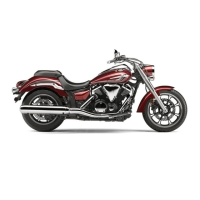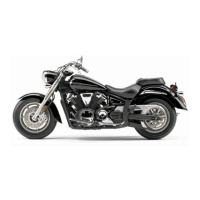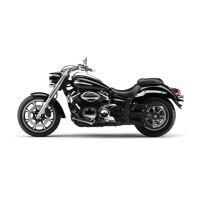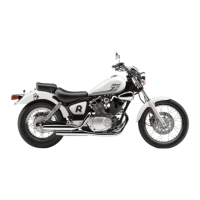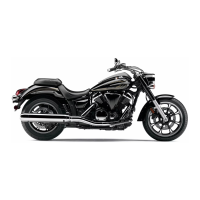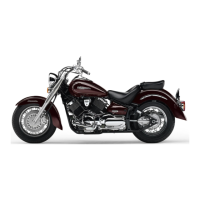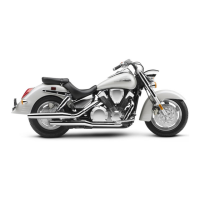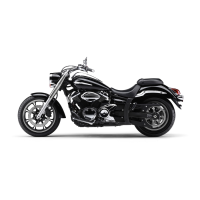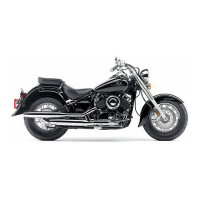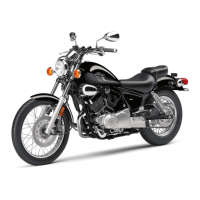Do you have a question about the Yamaha Midnight Star XVS950A and is the answer not in the manual?
As the vehicle's owner, you are responsible for the safe and proper operation of your motorcycle.
Perform pre-operation checks, use proper techniques, and be conspicuous for safe operation.
Wear appropriate protective gear like helmets, jackets, boots, and gloves for safety.
Be aware of carbon monoxide hazards from engine exhaust, especially in enclosed areas.
Locates and describes the motorcycle's controls and instrument panel.
Identifies and explains the function of various indicator and warning lights.
Warns if the engine oil level is low.
Warns when the fuel level is low.
Indicates a problem detected in the engine's monitoring system.
Describes the speedometer, odometer, and other functions of the meter unit.
Identifies and explains the function of left handlebar switches.
Identifies and explains the function of right handlebar switches.
Used to stop the engine in normal or emergency situations.
Used to crank the engine with the starter.
Location and operation of the clutch lever for disengaging/engaging the clutch.
Location and operation of the shift pedal for changing gears.
Location and operation of the brake lever for applying the front brake.
Location and operation of the brake pedal for applying the rear brake.
Information on fuel type, capacity, and safety precautions during refueling.
Checks for fuel level, line, and tank breather/overflow hose.
Checks for oil level, vehicle for oil leakage.
Checks operation, fluid level, lever play, and pads.
Checks operation, fluid level, pads, and system for leakage.
Checks for damage, tire condition, tread depth, and air pressure.
Instructions for starting the engine, including conditions for ignition circuit.
Guidance on breaking in the engine for the first 1600 km (1000 mi).
Scheduled maintenance and lubrication tasks for various vehicle components.
Checking the engine oil level and procedures for changing oil/filter.
Procedure for changing engine oil and replacing the oil filter cartridge.
Information on tire performance, durability, safety, and air pressure.
How to check and adjust tire air pressure for safe operation.
Procedure for checking tire sidewall, tread depth, and damage.
Procedure for checking wear on front and rear brake pads.
How to check the brake fluid level and refill if necessary.
Information on when and how to change brake fluid and related parts.
A chart to help diagnose common starting problems (fuel, ignition, battery).
As the vehicle's owner, you are responsible for the safe and proper operation of your motorcycle.
Perform pre-operation checks, use proper techniques, and be conspicuous for safe operation.
Wear appropriate protective gear like helmets, jackets, boots, and gloves for safety.
Be aware of carbon monoxide hazards from engine exhaust, especially in enclosed areas.
Locates and describes the motorcycle's controls and instrument panel.
Identifies and explains the function of various indicator and warning lights.
Warns if the engine oil level is low.
Warns when the fuel level is low.
Indicates a problem detected in the engine's monitoring system.
Describes the speedometer, odometer, and other functions of the meter unit.
Identifies and explains the function of left handlebar switches.
Identifies and explains the function of right handlebar switches.
Used to stop the engine in normal or emergency situations.
Used to crank the engine with the starter.
Location and operation of the clutch lever for disengaging/engaging the clutch.
Location and operation of the shift pedal for changing gears.
Location and operation of the brake lever for applying the front brake.
Location and operation of the brake pedal for applying the rear brake.
Information on fuel type, capacity, and safety precautions during refueling.
Checks for fuel level, line, and tank breather/overflow hose.
Checks for oil level, vehicle for oil leakage.
Checks operation, fluid level, lever play, and pads.
Checks operation, fluid level, pads, and system for leakage.
Checks for damage, tire condition, tread depth, and air pressure.
Instructions for starting the engine, including conditions for ignition circuit.
Guidance on breaking in the engine for the first 1600 km (1000 mi).
Scheduled maintenance and lubrication tasks for various vehicle components.
Checking the engine oil level and procedures for changing oil/filter.
Procedure for changing engine oil and replacing the oil filter cartridge.
Information on tire performance, durability, safety, and air pressure.
How to check and adjust tire air pressure for safe operation.
Procedure for checking tire sidewall, tread depth, and damage.
Procedure for checking wear on front and rear brake pads.
How to check the brake fluid level and refill if necessary.
Information on when and how to change brake fluid and related parts.
A chart to help diagnose common starting problems (fuel, ignition, battery).
| Displacement | 942 cc |
|---|---|
| Bore x Stroke | 85.0 mm x 83.0 mm |
| Compression Ratio | 9.0:1 |
| Fuel System | Fuel injection |
| Ignition | TCI |
| Transmission | 5-speed |
| Final Drive | Belt |
| Front Suspension | Telescopic fork |
| Rear Suspension | Swingarm |
| Rear Tire | 170/70-16 |
| Ground Clearance | 140 mm |
| Engine Type | V-twin |
| Front Brake | Hydraulic disc |
| Rear Brake | Hydraulic disc |
| Front Tire | 130/90-16 |
